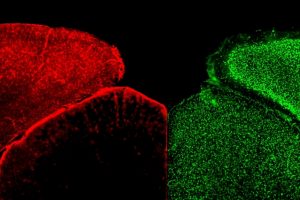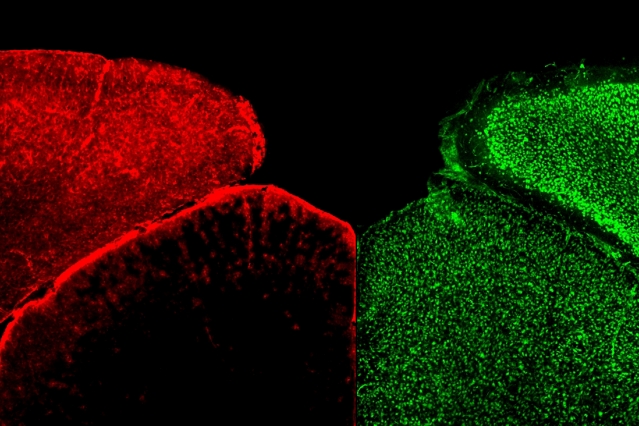
In this image of a mouse visual cortex, astrocytes (stained red) appear about as abundant as neurons (green). Image courtesy of Rodrigo Garcia/Picower Institute
[Source: MIT News, David Orenstein | Picower Institute for Learning and Memory, February 12, 2018]
With a new grant, a Picower Institute team is studying the role of astrocytes, which may partner with neurons to process information in the brain.
Neurons are the star of the show in brain science, but MIT researchers believe they don’t work alone to process information.
In new research funded by a $1.9 million grant from the National Institutes of Health, a team at MIT’s Picower Institute for Learning and Memory is working to uncover the likely crucial role of a supporting cast member with a stellar-sounding name: the astrocyte. The work could ultimately provide insight into many brain disorders.
Astrocytes are at least as abundant in the brain as neurons, but because they don’t spike with electrical impulses like neurons do, they’ve essentially been “invisible” in studies of how brain circuits process information, says Mriganka Sur, the Newton Professor of Neuroscience in the Department of Brain and Cognitive Sciences and director of the Simons Center for the Social Brain at MIT. Astrocytes have instead been appreciated mostly for shuttling various molecules and ions around to keep the brain’s biochemistry balanced and functioning.
While they don’t spike, astrocytes do signal their activity with increases of calcium. A decade ago in Science, Sur and colleagues used that insight to discover that astrocyte activity in the visual cortex, the part of the brain that processes vision, matched in lock-step with the activity of neurons in response to visual stimuli. That suggested that astrocytes make a vital contribution to vision processing. In the new study, Sur’s lab will investigate exactly what astrocytes are doing, for instance, to regulate the formation of neural connections called synapses and how the calcium activity arises and what difference that activity makes. They’ll look not only during the course of normal vision, but also during the critical period early in life when vision is first developing.
Using sophisticated and precise imaging tools, Sur’s team will monitor astrocyte and neuron activity in the visual cortex as mice see different stimuli. They’ll also use genetic and pharmaceutical tools to manipulate astrocyte activity. A key mechanism that’s likely involved, Sur says, is the way astrocytes deploy a molecule called GLT1 to regulate the level and time course of the neurotransmitter glutamate. Glutamate is vital because it mediates communication between neurons across synapses. By systematically manipulating the GLT1 activity of astrocytes in the visual cortex and measuring the effects, Sur says, the team will be able to determine how astrocytes contribute to the performance and formation of neural circuits.
“Just as neurons have their spiking code, we think there is an astrocyte calcium code that reflects and works in partnership with neurons,” Sur says. “That’s totally underappreciated but very important.”
